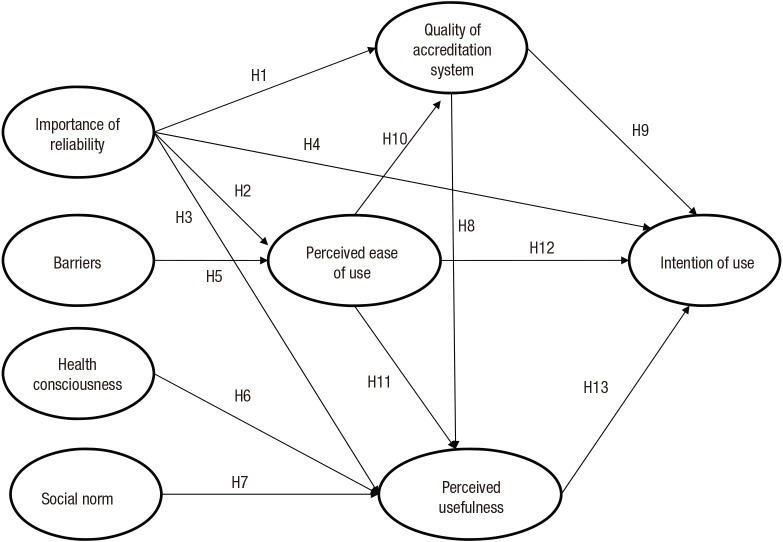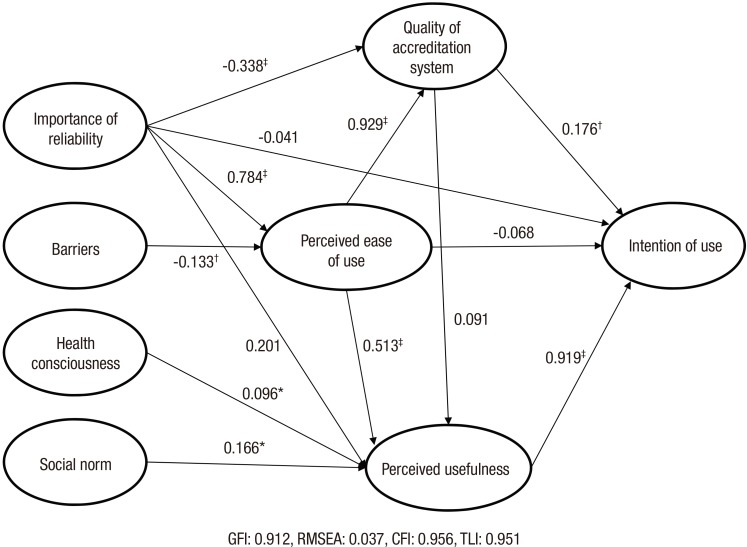J Korean Med Sci.
2017 Nov;32(11):1757-1763. 10.3346/jkms.2017.32.11.1757.
Analysis of the Factors Affecting Consumer Acceptance of Accredited Online Health Information
- Affiliations
-
- 1Department of Health Policy and Management, Kangwon National University College of Medicine, Chuncheon, Korea.
- 2Department of Health Management, Sahmyook University, Seoul, Korea.
- 3Korea Institute of Drug Safety and Risk Management, Anyang, Korea. bgkim@drugsafe.or.kr
- KMID: 2390300
- DOI: http://doi.org/10.3346/jkms.2017.32.11.1757
Abstract
- With the increasing use of the internet and the spread of smartphones, health information seekers obtain considerable information through the internet. As the amount of online health information increases, the need for quality management of health information has been emphasized. The purpose of this study was to investigate the factors affecting the intention of using accredited online health information by applying the extended technology acceptance model (Extended-TAM). An online survey was conducted from September 15, 2016 to October 3, 2016, on 500 men and women aged 19-69 years. The results showed that the greatest factor influencing the acceptance of the accredited health information was perceived usefulness, and the expectation for the quality of the accreditation system was the most important mediator variable. In order to establish the health information accreditation system as a means to provide easy and useful information to the consumers, it is necessary to carry out quality management and promote the system through the continuous monitoring of the accreditation system.
Figure
Cited by 1 articles
-
Gap between Perceived eHealth Literacy and Ability to Use Online Cancer-Related Information
Saerom Kim, Keeho Park, Heui Sug Jo
J Korean Med Sci. 2020;35(24):e187. doi: 10.3346/jkms.2020.35.e187.
Reference
-
1. Kim NS, Lee KE, Son HJ. Comparison of health consciousness and smart-phone literacy according to the type of health information seeking behavior on the Internet among one university students. J Health Inform Stat. 2016; 41:112–122.2. Kim BG. The influential factors for the acceptability of the health information website accreditation [dissertation]. Chuncheon: Kangwon National University;2017.3. Kim MY, Tae YS, Jung KI. Evaluation of gastric cancer information web sites in Korea. J Korean Acad Nurs Adm. 2009; 15:5–15.4. Seomun GA, Lee SJ, Lee SM. Evaluation of Asthma-related websites. J Korean Soc Med Inform. 2004; 10:321–328.5. Baker L, Wagner TH, Singer S, Bundorf MK. Use of the Internet and e-mail for health care information: results from a national survey. JAMA. 2003; 289:2400–2406. PMID: 12746364.6. England CY, Nicholls AM. Advice available on the Internet for people with coeliac disease: an evaluation of the quality of websites. J Hum Nutr Diet. 2004; 17:547–559. PMID: 15546433.7. Lee KA, Park YK, Kim JM, Oh SW, Lee KH. Study on establishing database management, accreditation and registration system for nutrition education materials. Seoul: Korean Nutrition Society;2011.8. Davis FD. Perceived usefulness, perceived ease of use, and user acceptance of information technology. Manage Inf Syst Q. 1989; 13:319–340.9. Venkatesh V, Davis FD. A theoretical extension of the technology acceptance model: four longitudinal field studies. Manage Sci. 2000; 46:186–204.10. Gefen D, Karahanna E, Straub DW. Trust and TAM in online shopping: an integrated model. Manage Inf Syst Q. 2003; 27:51–90.11. Shih HP. An empirical study on predicting user acceptance of e-shopping on the Web. Inf Manage. 2004; 41:351–368.12. Song TM. The analysis of influential factors for the acceptability of the health information website. Health Soc Welf Rev. 2005; 25:143–182.13. Cho HH. Study on influence of perceived quality factor of smartphone on satisfaction & continued use intention: from the standpoint of updated Delone & McLean's information system success model. Entrue J Inf Technol. 2012; 11:167–180.14. Porter CE, Donthe N. Using the technology acceptance model to explain how attitudes determine Internet usage. J Bus Res. 2006; 59:999–1007.15. Roh KS. Statistical Analysis of SPSS & AMOS 21. Seoul: Hanbit Academy;2014.16. Jung SI, Woo J, Kim YT, Kwak SG. Validation of the Korean-version of the Clinical Assessment Interview for Negative Symptoms of Schizophrenia (CAINS). J Korean Med Sci. 2016; 31:1114–1120. PMID: 27366011.17. Seok H, Yoon JH, Lee W, Lee JH, Jung PK, Roh J, Won JU. The perceived socioeconomic status is an important factor of health recovery for victims of occupational accidents in Korea. J Korean Med Sci. 2016; 31:164–170. PMID: 26839467.18. Noh GY, Choi J, Kwon MS. A test of extended technology acceptance model on health information seeking on the Internet. Korea J Broadcast Telecommun Stud. 2013; 27:49–85.19. Choi M, Seo PK, Choi MI, Paek HJ. Factors associated with health-specific TV viewing intention: application of the technology acceptance model. Korean J Journal Commun Stud. 2014; 58:362–389.20. Deng Z, Liu S, Hinz O. The health information seeking and usage behavior intention of Chinese consumers through mobile phones. Inf Technol People. 2015; 28:405–423.21. Liu YC, Huang YA, Wang MY. Exploring users’ intention to use health information on a bulletin board system. Int J Cyber Soc Educ. 2014; 7:89–96.22. Chau PY. An empirical investigation on factors affecting the acceptance of CASE by systems developers. Inf Manage. 1996; 30:269–280.
- Full Text Links
- Actions
-
Cited
- CITED
-
- Close
- Share
- Similar articles
-
- The Impacts of Consumer's Subjective Health Literacy on Health Websites Acceptance and Empowerment
- Quality Evaluation of Online Health Information Related to Young Child
- Survey on the consumer preference for the internet health information of the patients' online community members
- Social Network Analysis of Elders' Health Literacy and their Use of Online Health Information
- Influence of food-related lifestyle and nutritional knowledge on online grocery shopping among adults in Jeju



